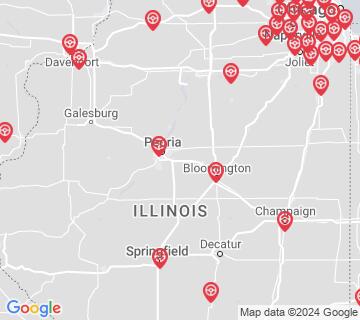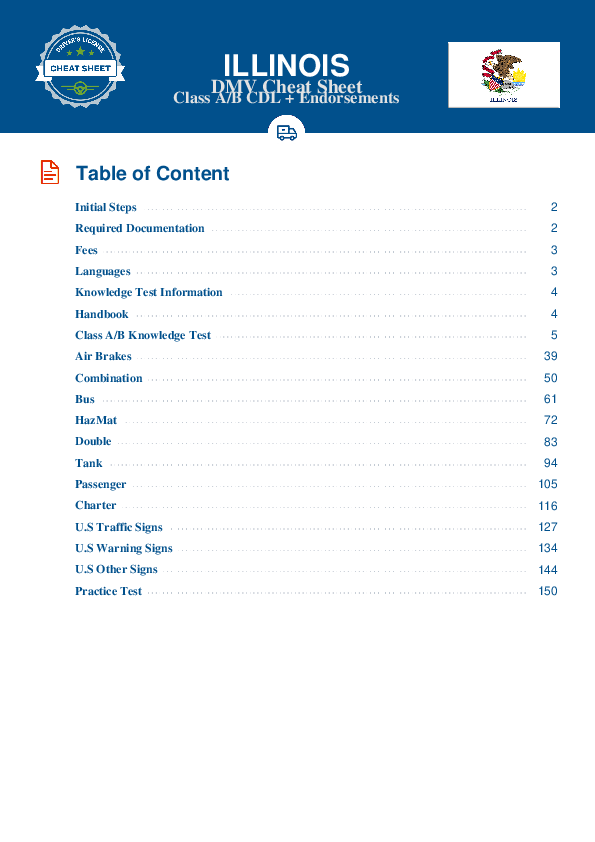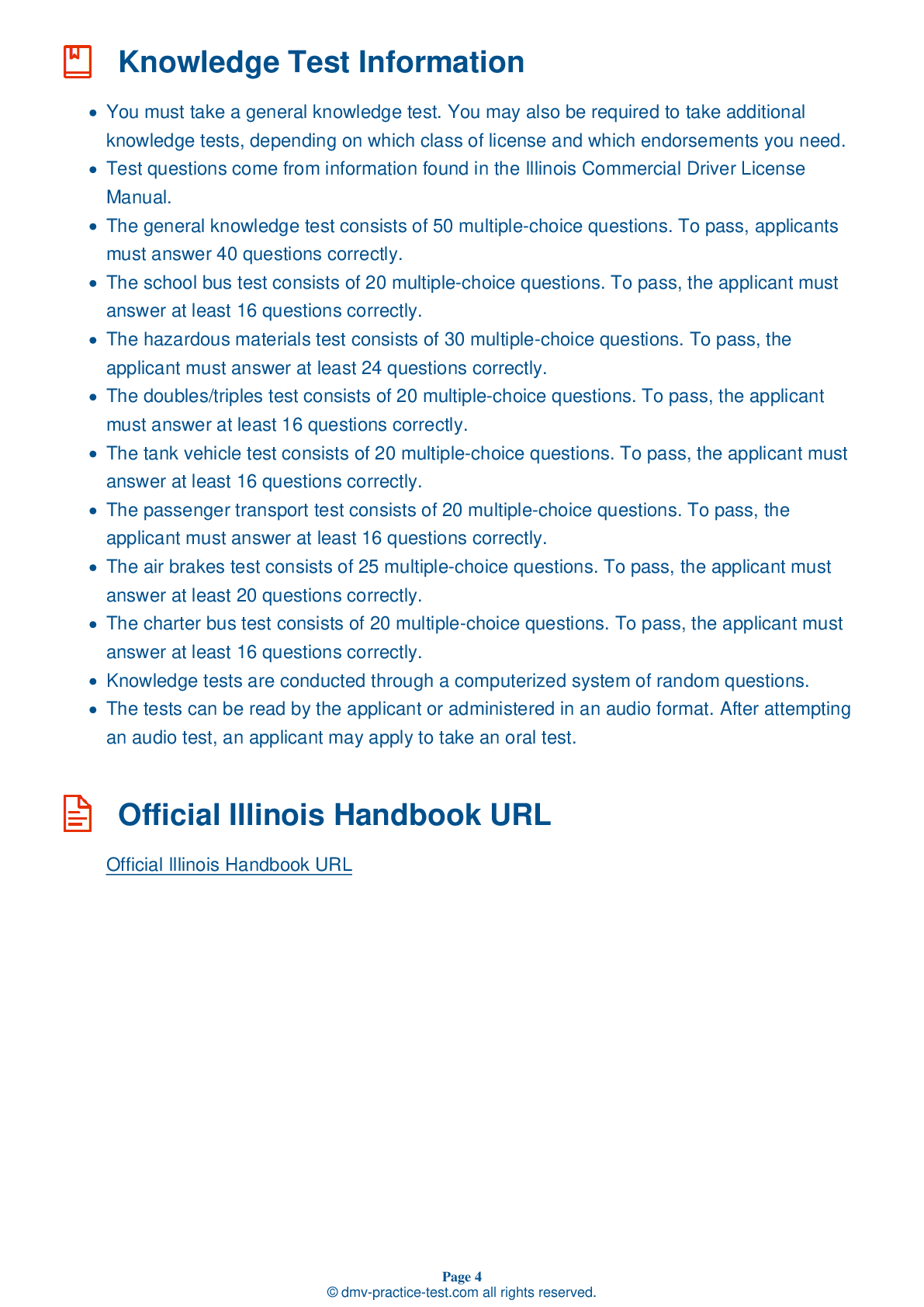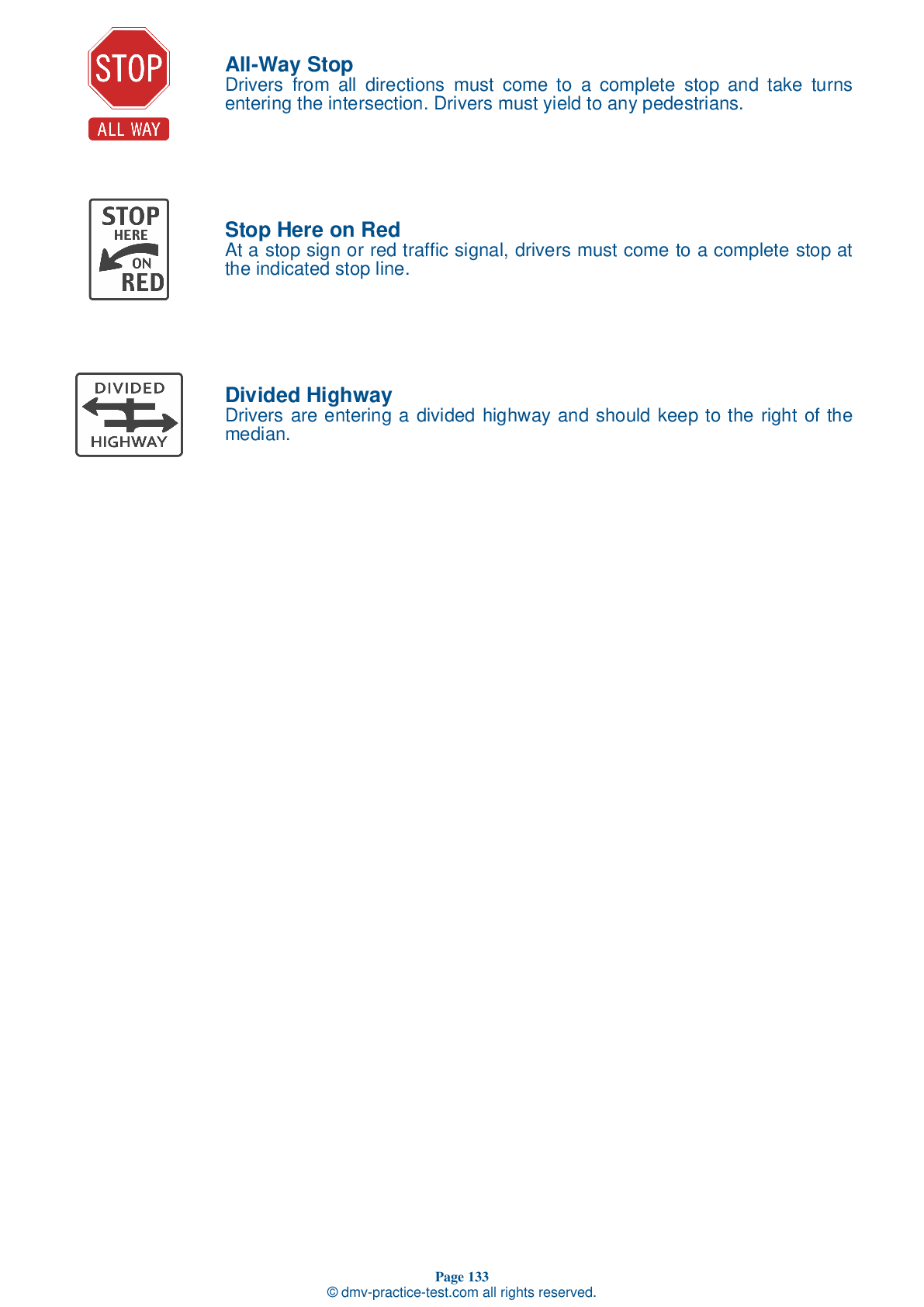Knowledge Test Class B #1
Class B Driving Test | Illinois 2025 #1 Page 7 of 7
Train for FREE online with our Illinois class B license test. The official exam test consists of several obligatory parts, with all of them checking your knowledge of different blocks of road rules. If you need to obtain a IL CDL class B permit in 2025, practice as much as possible. Free sample tests published on our website will help you check and improve your knowledge and boost your grades. Please bear in mind that CDL class B requirements may vary from state to state.
50
40
20
43 . On slippery roads, you should:
Accelerate and decelerate frequently.
Make sure to drive slowly and smoothly on slippery roads. Do not pass slower vehicles unless it is necessary to do so. Avoid frequently changing your speed under such conditions.
44 . An applicant will be denied a hazardous materials endorsement if they:
Already have a driver license.
Your application for a hazardous materials endorsement can be denied, or your existing endorsement canceled, if you do not have legal permanent status in the United States; you renounce U.S. citizenship; you are wanted for, under indictment for, or convicted of certain felonies; you are judged mentally incompetent or are involuntarily committed to a mental institution; or you are deemed by the Transportation Security Administration to pose a security threat.
45 . Before starting down a hill, you should:
Move into the left lane.
Always downshift before beginning to drive downhill. Take the hill at a speed that does not require you to overuse your brakes.
46 . Distracted driving:
Is encouraged on uncrowded roads.
Mental distractions can be just as dangerous as physical ones. It is possible for a person to look right at a hazard on the road but fail to notice it because their thoughts are occupied by something else.
47 . If someone pulls out in front of you and you cannot stop to avoid a crash, you should:
Accelerate.
If another vehicle pulls out in front of you, it is appropriate to brake as long as there is room for your vehicle to stop while you are using the appropriate braking technique. However, if you do not have room to stop, swerving may be a safer response.
48 . Test the low pressure warning signal:
Before every trip.
It is essential that your low pressure warning light function properly. After allowing the system to charge, you can test the warning signal by rapidly applying and releasing the brake pedal. This will release air from the braking system and the warning signal should come on when pressure drops to a dangerous level.
49 . Using an Anti-Lock Braking System (ABS):
Provides more control.
An Anti-Lock Braking System (ABS) helps prevent wheel lockup during hard braking. While it provides better control, it does not necessarily shorten a vehicle's stopping distance.
50 . Exceeding the number of pull-ups allotted for a single exercise will result in:
An extra point against your score.
A driver is allowed to use two pull-ups without penalty during any skills test exercise, aside from the straight line backing exercise, during which only one pull-up is permitted. Exceeding the number of permitted pull-ups during a single exercise will result in automatic failure of the basic vehicle control skills test.
Search the best driving school in your neighbourhood
2025 Illinois | Frequently Asked Questions
A CDL Class B license in Illinois allows you to operate single vehicles with a gross vehicle weight rating (GVWR) of 26,001 pounds or more, or any such vehicle towing another not exceeding 10,000 pounds. It also permits the operation of vehicles designed to transport 24 passengers or more, including the driver.
A Class B Commercial Driver's License (CDL) in Illinois allows you to operate single vehicles with a gross vehicle weight rating (GVWR) of 26,001 pounds or more, or a towed vehicle not exceeding 10,000 pounds GVWR. This includes buses, farm labor vehicles, and any vehicles designed to transport 16 to 23 passengers including the driver.
To acquire a Class B CDL license in Illinois, you must be at least 18 years old (21 for interstate driving), possess a valid non-CDL driver's license, pass a vision test, and obtain a medical certificate. You'll also need to pass written knowledge tests and a skills test, which includes a pre-trip vehicle inspection, a basic controls test, and an on-road driving exam.
In Illinois, you must be at least 18 years old to qualify for a Class B Commercial Driver's License (CDL) for intrastate driving (within Illinois only). However, to drive across state lines or to carry hazardous materials, you must be at least 21 years old.
Endorsements for a Class B CDL license in Illinois are not necessary but can be beneficial. They allow you to operate specific types of vehicles. For instance, a passenger endorsement allows you to drive a bus, while a tank vehicle endorsement lets you drive tank trucks. Each endorsement requires passing additional written and/or skills tests.
The Class B CDL skills assessment in Illinois comprises three parts: a pre-trip vehicle inspection to check your understanding of your vehicle and if it's safe to drive, a basic controls test to assess your control over the vehicle, and an on-road driving test to evaluate your driving skills in various road situations and traffic conditions.
Yes, Class B CDL license holders in Illinois are limited to operating vehicles with a Gross Vehicle Weight Rating (GVWR) of 26,001 pounds or more, or towing vehicles not exceeding 10,000 pounds GVWR. They can't operate Class A vehicles unless they have the appropriate Class A endorsement. Also, transporting passengers or hazardous materials requires specific endorsements.
Yes, in Illinois, the written Class B CDL test is available in languages other than English. The Illinois Secretary of State's office offers the test in Spanish, Polish, and some other languages. However, federal regulations require that all CDL holders must be able to read and speak English sufficiently to converse with the general public, understand traffic signs and signals, and respond to official inquiries.
Yes, if you have a disability, you can request accommodations for the Class B CDL written exam in Illinois. You'll need to provide documentation of your disability and specify the type of accommodation needed. It's advised to make this request well in advance of your scheduled test date to give the DMV time to arrange appropriate accommodations.
Yes, if you don't pass the Class B CDL written test in Illinois, you can retake it. However, you must wait until the next business day to do so. If you fail three times, you'll need to start the application process over again. Remember, there may be additional fees for retaking the test.




